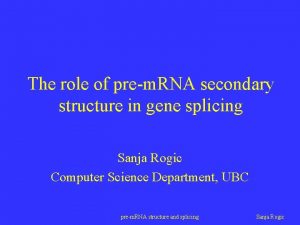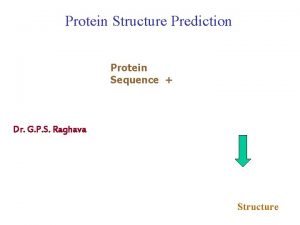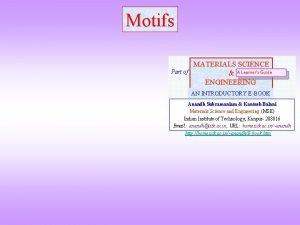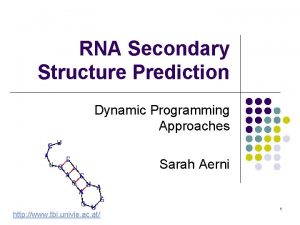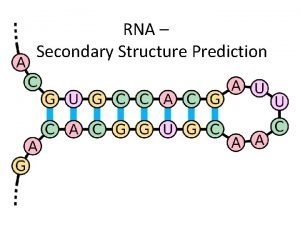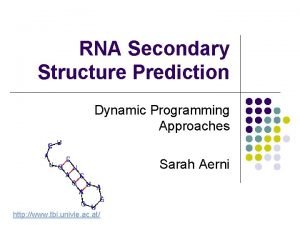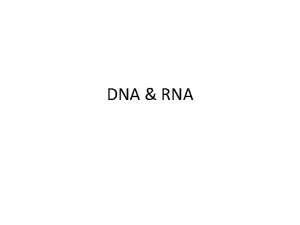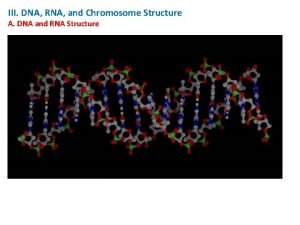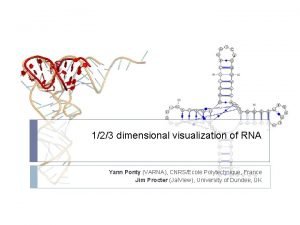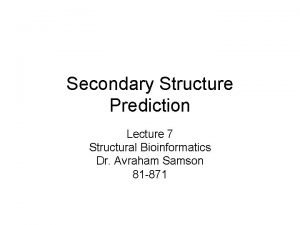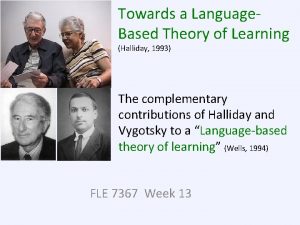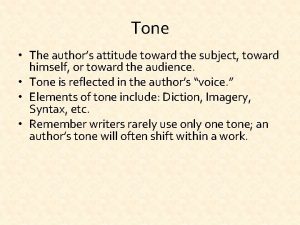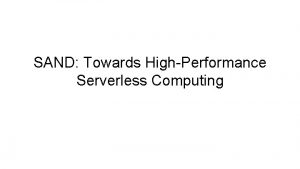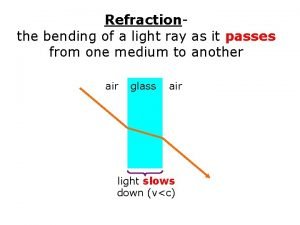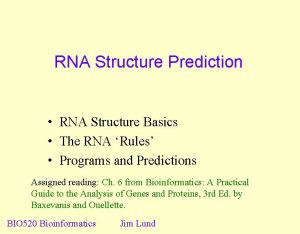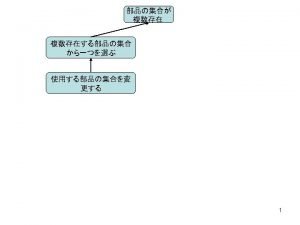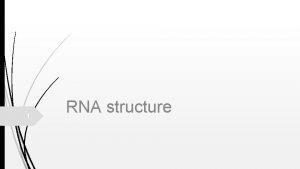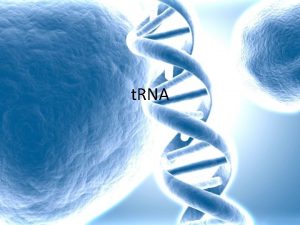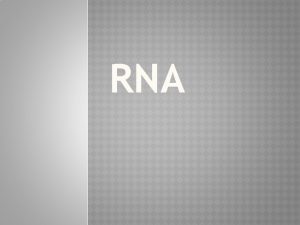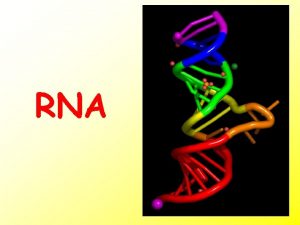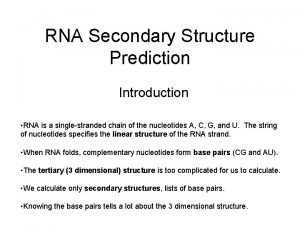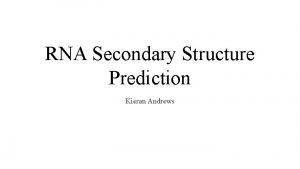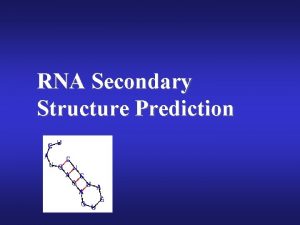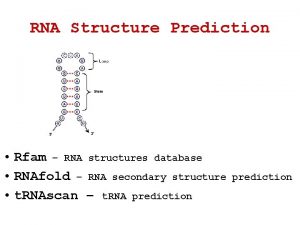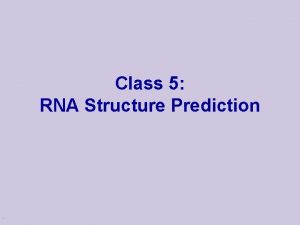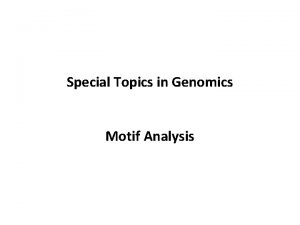Towards RNA structure prediction 3 D motif prediction

















- Slides: 17

Towards RNA structure prediction: 3 D motif prediction and knowledge -based potential functions Christian Laing Tamar Schlick’s lab Courant Institute of Mathematical Sciences Department of Chemistry New York University

RNA folding is hierarchical Sequence Secondary Structure Annotated diagram 3 D Structure 5‘g. GACUCG GGGUGCCC UUCUGCGU GAAGGCUG AGAAAUACC CGUAUCAC CUGAUCUG GAUAAUGC CAGCGUAG GGAAGUUc 3' TPP riboswitch (PDB: 2 GDI) • Tertiary motifs serve as modular building blocks in the RNA architecture. • To understand the role of RNA tertiary motifs in RNA folding will help to understand RNA 3 D prediction.

Annotating 3 D RNA • Selected seven key RNA tertiary motifs: coaxial helix, A-minor motif, ribose zipper, tetraloop-tetraloop receptor, pseudoknot, kissing hairpin, and t. RNA D-loop: T-loop. • Searched RNA tertiary motifs via different computer programs • Annotate tertiary interaction motifs. • Perform analysis over the diagrams produced.

Examples RNA junctions have a high probability (84%) to contain at least one coaxial helix.

Distribution of tertiary motifs • For 54 high-resolution RNA structures, 615 RNA tertiary interactions were found. • Ribose zippers, coaxial helices and A-minor interactions are highly abundant (88%).

Correlated motifs • Several A-minor motifs (64%) are involved with coaxial helices. • Coaxial helices (70%) interact with A-minor. • Most ribose zippers (70%) contain an A-minor. • Every loop-loop receptor contains a ribose zipper, which in turn contains one or more A-minor motifs 87% of the time. Group I intron (PDB: 1 HR 2) RNA V. 5 1119 (2001)

Can we predict coaxial stacking? HCV virus fragment (PDB: 1 KH 6) NAT. STRUCT. BIOL. V. 9 370 2002

Topology of 4 -way junctions in folded RNAs Family H Family K Analysis on 24 junctions: GUIDELINES • A coaxial staking Hi-Hi+1 is enhanced when Ji, i+1 is small. • There is a strong preference for a H 1 -H 4 stacking. • Coaxial helices in family H have similar lengths. • Pseudoknots usually stack their helices. Family X Family t Family <J 12> <J 23> <J 34> <J 41> Coaxial H. H: 10 H: 1 2. 0 0 0. 5 0 2. 4 0 0 H 1 -H 4; H 2 -H 4 H 1 -H 2; H 3 -H 4 K: 3 K: 4 K: 1 5. 0 4. 3 2 2. 3 3. 8 0 4. 3 1. 8 1 0. 3 1. 3 0 H 1 -H 4 H 3 -H 4 H 2 -H 3 X: 5 4. 4 2. 2 5. 6 3. 8 t: 1 6 4 5 1 H 2 -H 4

A-minor involved in long-range interactions

Statistical Potentials for A-minor prediction • The adenosine (A) can be located in four single stranded regions: internal (I) and terminal (T) loops, junctions (J), and other (O). • The helix receptor (R) can be located in five positions relative to the end site of a helix. • The potential function for an A-minor is defined by: • is the observed number of interacting pairs • is the expected number of interacting pairs • The statistical free energy for each A-minor is:

Improving coarse-grained model Rosetta: - 1 -bead model (only the base). - Neglect sugar and phosphate. - Only one RNA (23 S r. RNA) was considered. PNAS V. 104 No. 37 14664 -9 (2007) Possible improvements: - 3 -bead model to consider base, sugar, and phosphate. - Consider our 54 -nonredundant RNA dataset. PNAS V. 102 No. 19 6789 -94 (2005)

From 2 D to 3 D: RNA assemble Assume we know the RNA secondary structure (and possible some constrains), how can we use this knowledge into our Mesoscopic model? • Stems can be described by type-A helices. • Programs such as Assemble (Westhof) and RNA 2 D 3 D (Shapiro) can be used but require manual intervention.

Suggested future directions • Design statistical potentials for coaxial stacking. • The combination of A-minor/coaxial helix prediction may lead to stronger arguments. • Design statistical potentials to predict non canonical basepairs (Leontis/Westhof), and explore the possibility to use them with dynamic programming. • Test the statistical potentials (threading, decoys). • There are 272 non-redundant 4 -way junctions in the RNA junction database that can be analyzed topologically and geometrically.

Acknowledgements Yurong Xin and Tamar Schlick Many thanks to: Hin Hark Gan Sean Mc. Guffee Shereef Elmetwaly Human Frontier Science Program NSF/NIGMS initiative in Mathematical Biology (DMS 0201160)

Topology of 3 -way junctions in folded RNAs (Lescoute & Westhof RNA 2006 12: 83 -93) Analysis over 33 junctions. Back up slide

Back up slide

Back up slide
 Rna secondary structure prediction
Rna secondary structure prediction Rna secondary structure prediction
Rna secondary structure prediction Motif berasal dari bahasa inggris yaitu
Motif berasal dari bahasa inggris yaitu Microwaves definition science
Microwaves definition science Canonical base
Canonical base Rna secondary structure
Rna secondary structure Pseudoknot structure
Pseudoknot structure 3 componets of dna
3 componets of dna Dna rna
Dna rna Varna rna structure
Varna rna structure Phd secondary structure prediction
Phd secondary structure prediction Halliday 1993
Halliday 1993 Savukku nora money
Savukku nora money The authors attitude towards a subject
The authors attitude towards a subject Together towards improvement
Together towards improvement Sand: towards high-performance serverless computing
Sand: towards high-performance serverless computing Hrd strategy towards 2030
Hrd strategy towards 2030 Light bending towards the normal
Light bending towards the normal
